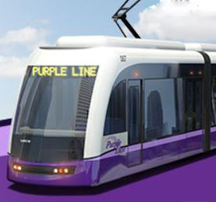Bus Rapid Transit and MARC Expansion
Action Committee for Transit supports the Countywide Transit Corridors Functional Master Plan. Today, buses sit in the same traffic as every automobile, which reduces bus speed, reliability and competitiveness. We must increase our “people moving capacity” rather than seek to move the most cars at the fastest speeds possible. Widening roads is not only expensive, but it creates a hostile environment for pedestrians crossing and bicyclists. How can we move more people without widening roads — use part of our existing roadways for BRT.
One bus carries as many people at 60 single-occupancy-vehicles. By repurposing part of the public right of way for use by BRT, buses will travel in their own lanes, bypassing the gridlock, and serve as their own advertisement. BRT’s features include high frequency service in peak hours, electronic “next bus” displays at stations, pre-pay kiosks so drivers don’t have to collect fares, and entry via any and all doors (just like on MetroRail). Platforms built level to the bus allow wheel chair riders and strollers to roll onboard.
BRT also reduces the cost of transportation — $10,000 is the annual cost of owning an automobile (These are AAA statistics.). With better public transit, two-earner households may be able to forego the second car and reduce their transportation costs. When teens and students can rely on transit rather than automobiles, this frees up parents from chauffeuring and also reduces the number of “new” drivers on the road. And someday, aging Baby Boomers can give up their cars and age in place using reliable transit.
Travel between suburban Activity Centers is quite common, but underserved by public transit. The East-West routes on the BRT master plan are key to providing better connectivity for getting to work, school and shopping throughout the county. Inclusion of these East-West routes and BRT travel in dedicated lanes will support the connectivity and speed needed for a thriving transit network.
The BRT will also be key to the growth of future land-use plans, such as the White Oak Science Gateway and White Flint.
WMATA’s “Priority Corridors Network” for the highest ridership corridors aligns closely with several of the routes in the BRT plan proposed by the Planning staff. ACT urges implementation of WMATA priority corridors as a “first step” to give the public better transit sooner. We suggest an initial pilot of the BRT program along New Hampshire Avenue. If SHA allows an existing lane of New Hampshire Avenue to be dedicated for buses, we could learn from field performance how local conditions affect the BRT. New Hampshire Avenue is the route of WMATA’s Metro-Extra K-9 line that will provide limited-stop service between the FDA in White Oak (a major employment center) and the Fort Totten Metro. Using this as a test case would allow planners to do “Design, Learn, Re-Design”. This can be done with minimal expense (several million dollars for a few more vehicles and for operation costs).
One final comment, Action Committee for Transit urges the Planning Board to separate out the last part of the draft document: MARC Brunswick Line Expansion (starting on page 69). We would like to see it addressed on its own merits so that MARC’s growth and expansion can move ahead quickly.

